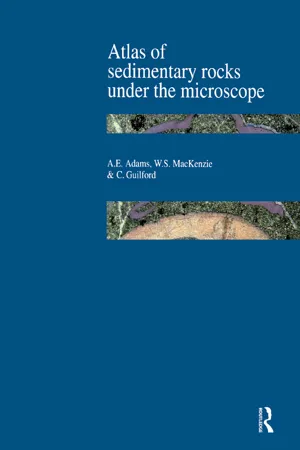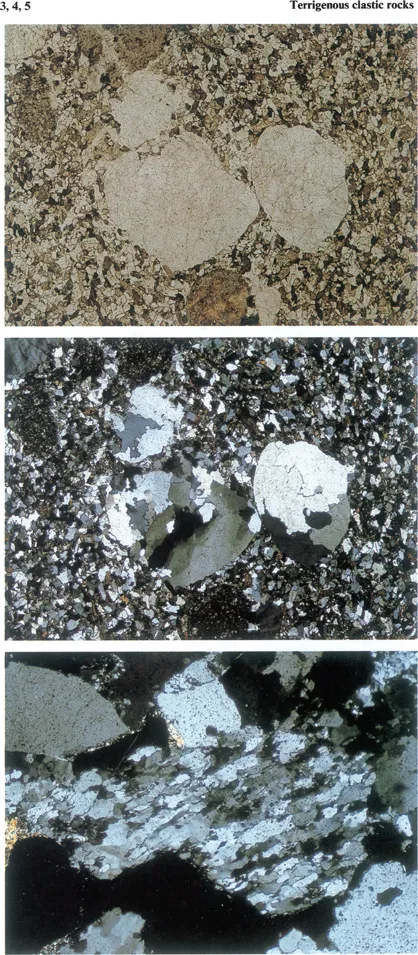
- 110 pages
- English
- ePUB (mobile friendly)
- Available on iOS & Android
eBook - ePub
Atlas of Sedimentary Rocks Under the Microscope
About this book
Provides a very clear guide to sedimentary rock types as seen under the microscope supported by practical aspects of slide preparation.
Frequently asked questions
Yes, you can cancel anytime from the Subscription tab in your account settings on the Perlego website. Your subscription will stay active until the end of your current billing period. Learn how to cancel your subscription.
No, books cannot be downloaded as external files, such as PDFs, for use outside of Perlego. However, you can download books within the Perlego app for offline reading on mobile or tablet. Learn more here.
Perlego offers two plans: Essential and Complete
- Essential is ideal for learners and professionals who enjoy exploring a wide range of subjects. Access the Essential Library with 800,000+ trusted titles and best-sellers across business, personal growth, and the humanities. Includes unlimited reading time and Standard Read Aloud voice.
- Complete: Perfect for advanced learners and researchers needing full, unrestricted access. Unlock 1.4M+ books across hundreds of subjects, including academic and specialized titles. The Complete Plan also includes advanced features like Premium Read Aloud and Research Assistant.
We are an online textbook subscription service, where you can get access to an entire online library for less than the price of a single book per month. With over 1 million books across 1000+ topics, we’ve got you covered! Learn more here.
Look out for the read-aloud symbol on your next book to see if you can listen to it. The read-aloud tool reads text aloud for you, highlighting the text as it is being read. You can pause it, speed it up and slow it down. Learn more here.
Yes! You can use the Perlego app on both iOS or Android devices to read anytime, anywhere — even offline. Perfect for commutes or when you’re on the go.
Please note we cannot support devices running on iOS 13 and Android 7 or earlier. Learn more about using the app.
Please note we cannot support devices running on iOS 13 and Android 7 or earlier. Learn more about using the app.
Yes, you can access Atlas of Sedimentary Rocks Under the Microscope by A.E. Adams,W.S. Mackenzie,C. Guilford in PDF and/or ePUB format, as well as other popular books in Physical Sciences & Geology & Earth Sciences. We have over one million books available in our catalogue for you to explore.
Information
Part 1
Terrigenous clastic rocks
Introduction
Terrigenous clastic sediments are made up of transported fragments derived from the weathering of pre-existing igneous, sedimentary or metamorphic rocks. These rocks are classified initially according to grain size, using the Udden-Wentworth scale (Table 1).
It is those terrigenous sediments of intermediate grain size — the coarser siltstones, sandstones and finer conglomerates and breccias — that are most usefully studied using the pétrographie microscope, since the grain types can be identified by this means. The principal component grain types are quartz, feldspar and rock fragments. The matrix of such sediments may be the fine-grained weathering products of the source rocks, such as clay minerals, or it may be a secondary cement.
Clays and shales are too fine-grained for study using the petrographic microscope and must be examined by electron microscopy or X-ray diffraction. The components of coarser conglomerates and breccias can usually be identified with the aid of only a hand lens.
The shape and roundness of the components of terrigenous clastic rocks are important in describing sedimentary textures. Categories of roundness for grains of high and low sphericity are shown in Fig. A. Sedimentary textures are discussed on p. 24.
Table 1. Grain-size classification of sediments


Fig. A Categories of roundness for grains of low and high sphericity (after Pettijohn et al., 1973)
Quartz
The most abundant grain type in sandstones and conglomerates is quartz. In addition to the size and shape of individual quartz grains, the following features should be observed since they may provide clues to the provenance of the sediment:
1. Whether the quartz grains are single crystals (monocrystalline) or are made up of a number of crystals in different orientations (polycrystalline).
2. Whether extinction is uniform (the grain extinguishes in one position on rotation of the stage) or undulose (the grain extinguishes over a range of at least 5° on rotation of the stage).
3. The presence or absence of inclusions.
4. In the case of polycrystalline grains, whether the crystal boundaries are straight or sutured.
1 and 2 show subrounded quartz grains which are single crystals, taken with plane-polarized light (PPL) and with crossed polars (XPL). The matrix between the sand grains contains opaque iron oxide and some calcite. The latter shows high-order pink and green interference colours.

1 and 2: Red Mountain Formation, Silurian, Birmingham, Alabama, USA; magnification × 38; 1 PPL, 2 XPL.
The three rounded grains in the centre of 3 and 4 are made up of a number of quartz crystals in different orientations and are thus composite or polycrystalline quartz. The composite nature of the grains is clear only in the view taken with polars crossed. Note that the boundaries between the crystals are sutured. This is characteristic of quartz from a metamorphic source. Composite quartz from igneous sources usually has straighter crystal boundaries. The much finer sediment surrounding the composite quartz grains contains monocrystalline quartz and brownish clasts of fine-grained material which are probably shale or slate fragments.
5 shows a composite quartz grain viewed under crossed polars, in which not only are the crystal boundaries within the grain sutured, but also the crystals are elongated in a preferred direction. Such grains are called sheared quartz or stretched metamorphic quartz. In this type of quartz, individual crystals normally show undulose extinction as a result of strain. Evidence for this in the example shown comes from the non-uniform interference colours shown by many of the crystals.

3 and 4: Trichrug Beds, Silurian, Pontarllechau, Dyfed, Wales; magnification × 16; 3 PPL, 4 XPL.
5: Carboniferous, Anglesey, Wales; magnification × 43, XPL.
5: Carboniferous, Anglesey, Wales; magnification × 43, XPL.
The quartz grain in the centre of the field of view in 6 appears to be a single homogeneous crystal. In 7 however, where the same field of view is seen under crossed polars, the quartz grain is clearly made up of parts of two crystals. One, comprising the upper left portion of the grain is showing a mid-grey interference colour, whereas the rest of the grain comprises a crystal with areas showing slightly different interference colours. The left- and right-hand sides are in extinction and interference colours become progressively paler towards the centre of the grain. Such a grain would show sweeping extinction when rotated. This phenomenon, known as undulose extinction, is a result of strain and is found in quartz grains from both igneous and metamorphic sources.
Quartz crystals may sometimes incorporate mineral inclusions and identification of the minerals may yield information about the provenance of the sediment. The quartz grain in the centre of 6 and 7 has a number of needle-shaped inclusions, although they are too small for the mineral to be identified at the magnification shown. Inclusions of the fluid present at the time of crystallization are common in quartz crystals and are known as fluid inclusions or vacuoles. 8 shows a quartz grain with abundant vac...
Table of contents
- Cover
- Half Title
- Title Page
- Copyright Page
- Table of Contents
- Preface
- Part 1 Terrigenous clastic rocks
- Part 2 Carbonate rocks
- Part 3 Other sedimentary rocks
- Appendix 1 Preparation of a thin section of a rock
- Appendix 2 Staining a thin section of a limestone
- Appendix 3 Preparation of a stained acetate peel of a limestone
- References
- Index